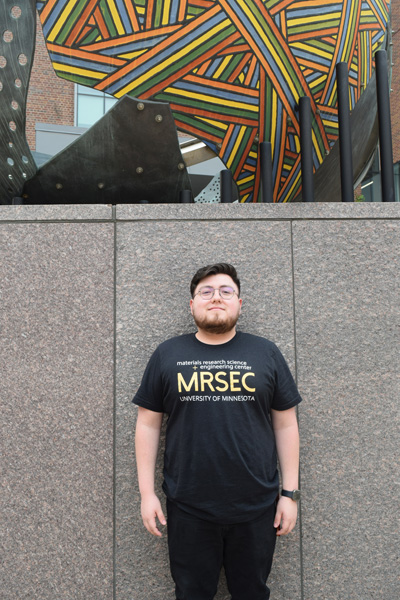
Home Institution: University of Texas RIo Grande Valley
REU Mentor: Frank Bates, Chris Ellison
Mechanical Properties of Structured Single Fibers and Non-Woven Mats
Nonwoven mats, predominantly composed of short/long fibers and porous fibers, have gained considerable contemporary interest due to their wide range of applications in engineering. From filtration media to medical devices, nonwoven mats exhibit valuable properties, making them versatile and sought-after in various fields. The fibers we use are made by the melt-blowing method and are composed of Polybutylene terephthalate (PBT) and Polystyrene (PS). We want to understand the mechanical properties of nonwovens with various fiber structures and compositions by performing tensile tests on mats with different PBT/PS blend and porous fibers. Distinct preparations such as heat treatment, bonding steps, and solvent treatment can provide more insight into their stability and deformation mechanisms. Working towards a deeper understanding of the mechanical properties, the objective is to investigate and analyze the combined mechanical behavior of both the single fiber and the fiber mat. This approach enables the exploration of mechanical properties, acknowledging the significance of both individual fibers and the overall mat structure, considering parameters such as fiber curvature and entanglements. The team expects to directly compare distinct polymer blends and evaluate how the different structures and treatments can affect the mechanical properties.
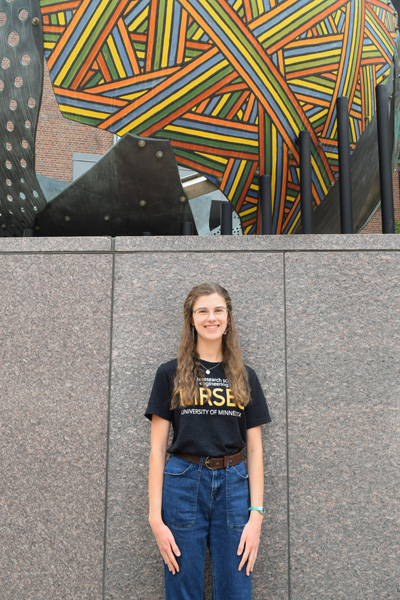
Home Institution: Georgia Institute of Technology
REU Mentor: Chris Ellison
Double Gyroid Formation of Polystyrene-Polylactide Block Copolymer Thin Films on Rigid and Flexible Substrates
Diblock copolymers self-assemble into various microphases, including the double gyroid, a set of periodic interwoven chiral networks. Double gyroids exhibit enticing optical properties, like circular dichroism. For strong circular dichroism, the orientation and surface termination of the gyroid unit cell must be controlled. Literature shows that changing the surface energy of substrates alters gyroid orientation in thin films. As a result, most studies employ a few standard substrates, which limits applications. This project explores how substrate choice influences double gyroid formation and orientation of polystyrene-polylactide block copolymer (PS-b-PLA) thin films. To facilitate the characterization of transmissive optical properties and to expand application areas, glass, PET, and PES membrane substrates were compared to standard silicon substrates. Surface energy and roughness of substrates were quantified through contact angle measurements and atomic force microscopy (AFM). PS-b-PLA thin films were spun cast and annealed on the chosen substrates, varying annealing time, temperature, and atmosphere to explore double gyroid formation. Double gyroids of various orientations were confirmed on most substrates via scanning electron microscopy and AFM after annealing PS-b-PLA films between 165°C-180°C. Overall, this work expands the range of substrates suitable for double gyroid formation and implies that substrate choice may even provide orientation control.
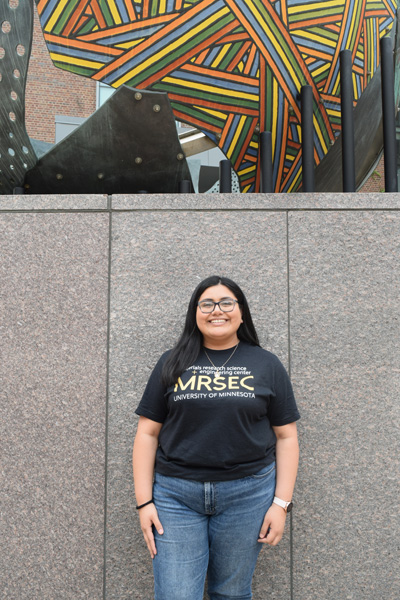
Home Institution: The University of Texas Rio Grande Valley
REU Mentor: Nathan Mara
Processing-Mechanical Property Correlations in Pharmaceutical Molecular Crystals
Mechanical properties of molecular crystals play a vital role in pharmaceutical tablet production. Tablet manufacturing processes are currently empirical and rely on an iterative process to optimize production, proving costly. Efforts are being made to utilize single crystal ingredient mechanical properties to predict the millability and tabletability of pharmaceutical tablets using nanoindentation. To quantify the mechanical properties of these crystals, a high-throughput method of nanoindentation is being applied. The use of nanoindentation is a cost-effective solution to modern tablet production efforts as it can test the properties of a single crystal to a finished tablet. This project has two primary goals – to quantify the modulus and hardness of Carbamazepine Dihydrate (C15H16N2O3) single crystals using Berkovich intenders and to study the stress-strain relationship of Succinic Acid (C4H6O4) using spherical indenters. Additional surface analysis was conducted using a scanning electron microscope (SEM) to study the topography of these single crystals. These studies are vital in developing a fundamental understanding of the deformation behavior of molecular crystals which can be implemented in predicting and improving pharmaceutical processes.
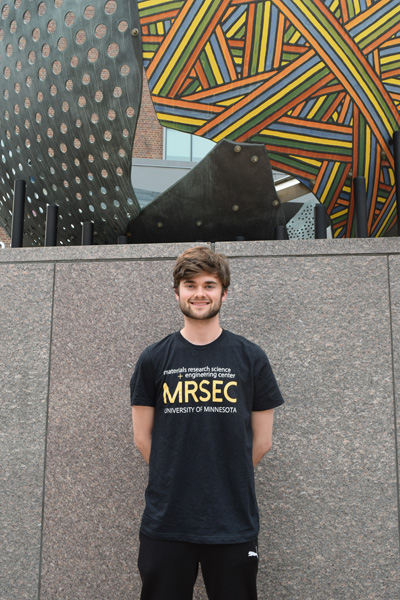
Home Institution: St. Olaf
REU Mentor: Xiang Cheng, Moumita Dasgupta
Engineering a Macroscale Model of E. Coli Swimming
We engineered an experimental model of bacterial flagella with four scaled up rigid flagella, rotated by stepper motors, surrounding a non-motorized flagella immersed in a tank of silicone oil. Escherichia coli (E .coli) are single-celled bacteria two micrometers in length with zero to ten flagella, helix-shaped appendages, about ten micrometers long. E. coli swim by using rotary motors embedded in their cell envelope that spin their flagella at a constant torque with a RPM faster than the turbine in a modern jet engine. These flagella are key to understanding how microorganisms move, however, their small size means the flagella are difficult to study. Therefore, by keeping Reynolds number constant between our model and the actual E. coli we create an accurate macroscale model to understand different microscale biophysical interactions. We fabricated flagella while keeping the design parameters like the ratio of their radius to length and pitch to length constant. My poster’s focus is on the model’s design and feasibility testing. On implementation, this model captures specific physical interactions between different structural and functional aspects of the bacteria’s swimming, which would be impossible to isolate and study in real E. coli.
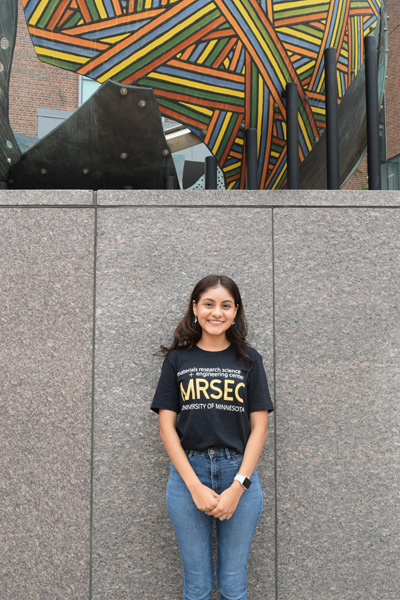
Home Institution:The University of Texas Rio Grande Valley
REU Mentor: Samira Azarin
Development of Nanomaterials for Ultrasound-Mediated Destruction of Metastatic Ovarian Tumors
Ovarian cancer is one of the most common cancers affecting women, many of these patients develop resistance to standard treatments. Graphene-based biomaterials have been used to deliver a sonosensitizer Chlorin E6 (Ce6) to ovarian cancer cells, enabling non-invasive killing via ultrasound treatment. The objective of this project was to develop a more biocompatible delivery platform for Ce6. A single emulsion solvent evaporation method was used to load Ce6 into poly lactic-co-glycolic acid (PLGA) nanoparticles. The process was optimized by varying the ratios of dichloromethane and dimethyl sulfoxide. Dynamic light scattering showed that the size and charge remained between 250 to 300 nm and -30 to -40 mV, respectively, for all batches. High-performance liquid chromatography showed Ce6 loading efficiencies ranging from 78.032 to 99.607 %. The biocompatibility of the Ce6-loaded PLGA was verified by evaluating viability of OVCAR-8 ovarian cancer cells upon exposure to the particles. Collectively, these results show the ability to develop a process for efficient loading of Ce6 into PLGA nanoparticles for a biocompatible Ce6 delivery platform. Future studies will focus on characterizing tumor killing by Ce6-loaded PLGA upon ultrasound treatment.
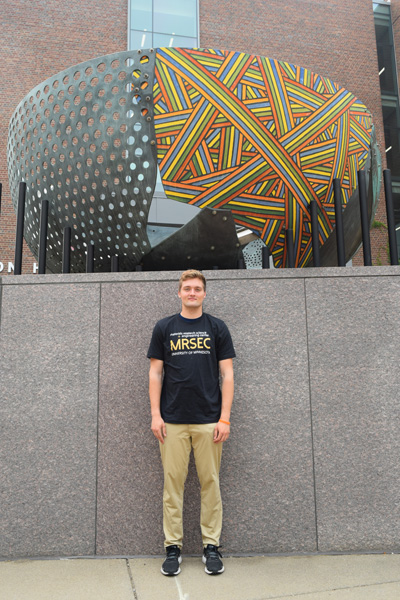
Home Institution:Bucknell University
REU Mentor: Tim Lodge
Micellization of PEE-PEO Block Copolymers in Organic Solvents for use as Perovskite Nanoreactors
Block copolymers are made up of chemically distinct polymeric segments connected through a covalent bond. The chemical dissimilarity between segments leads to a variety of self-assembled nanostructures both in bulk and solution. Block copolymer micelles have been studied extensively due to their uses in the fields of drug delivery and energy storage. The objective of the present study is to control the formation of poly(ethyl ethylene)-b-poly(ethyl oxide) (PEE-PEO) block copolymer micelles in organic solvents such as decane and squalane. The intent is to use PEE-PEO micelles as nanoreactors to grow perovskite nanocrystals, a material used to improve optical-electrical properties in solar cells and energy storage devices. As the micelle shape, size and distribution can greatly affect the stability and effectiveness of the perovskite nanocrystals, the micelle size and its distribution have been optimized by varying polymer concentration, temperature, solvent quality, and the method of preparation. Multi-angle dynamic light scattering measurements were carried out to determine the hydrodynamic radius of the micelles and the micelle size distribution. Micelles were also characterized using small-angle X-ray scattering to evaluate the shape of the micelles. Overall, the micelle size and distribution were found to be controlled best by tuning the temperature and solvent quality.
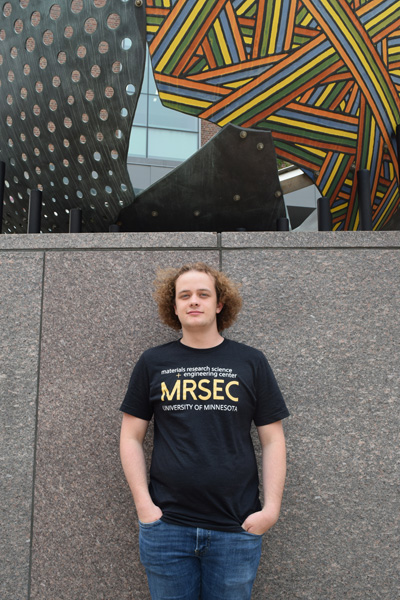
Home Institution: University of Iowa
REU Mentor: Michelle Calabrese
Poloxamer Gels in Biocompatible Ionic Liquids to Treat Middle Ear Infections
The current standard of care for otitis media (OM, middle ear infection) has many limitations including contribution to bacterial antibiotic resistance and unwanted side-effects. Recent research has highlighted the potential of aqueous, drug-loaded poloxamer gels (composed of hydrophilic and hydrophobic blocks) for treating OM. These formulations can be directly administered onto the eardrum for targeted, non-invasive drug delivery. However, small-molecule chemical permeation enhancers (CPEs) must be added to the poloxamer gels to enable drug transport across the eardrum, making formulation difficult. Choline-based ionic liquids (IL) are a potential solution to this problem as they are stable, biocompatible, and can serve as both a solvent and CPE. In this work, the interactions of biocompatible poloxamers and choline-based IL are investigated to fine-tune the rheological and structural properties of the drug delivery system. Poloxamer in choline-hexenoic IL and water was shown to transition to a gel state upon heating with a corresponding gel structure of body-centered-cubic (a = 83.5 A). The anion-to-cation ratio of IL and poloxamer concentration were varied to analyze its effect on sol-to-gel transition and associated final gel structure. The results obtained from this study can be exploited to develop more effective drug delivery routes to treat OM.
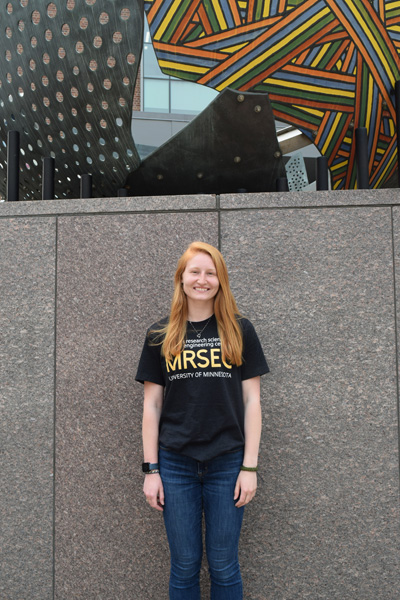
Home Institution: University of Texas Rio Grande Valley
REU Mentor: Michelle Calabrese
Optimizing the Synthesis of High Molecular Weight Thermoresponsive Triblock Copolymers for Processing Scalability
Stimuli-responsive block copolymers are used in a variety of applications including printable electronics, thermoresponsive spray coatings, and drug delivery systems. These polymers are especially favorable in applications due to their tunable properties, versatility, and potential scalability. Polymer architecture has a crucial role in responsiveness, and reversible addition-fragmentation chain transfer (RAFT) polymerization can be used to achieve well-controlled polymers. In this project, RAFT is used to synthesize low dispersity poly(N-isopropylacrylamide-b-dimethylacrylamide) (P(NIPAM-b-DMA)) triblock copolymers. Polymerization was carried out using two RAFT chain transfer agents, 2-(1-carboxy-1-methylethylsulfanylthiocarbonylsulfanyl)-2-methylpropionic acid (CMP) and 2-(dodecylthiocarbonothioylthio)-2-methylpropanoic acid (bis-DDMAT). CMP contains end carboxyl groups, while bis-DDMAT contains end dodecyl carbon chains creating different resulting triblock structures, which should lead to different behaviors in solution. While previous experiments utilizing these triblocks were limited to lower molecular weight polymers, larger molecular weight polymers tend to have higher tensile strength and better longevity in applications. Therefore, we are interested in raising the molecular weight of these polymers to study how this affects structure and processability. Following successful synthesis, cloud-point testing was performed to study optical properties of the polymers as a function of temperature. This work connecting polymer architecture to solution processability will be beneficial to increase the scalability of these stimuli-responsive polymers.
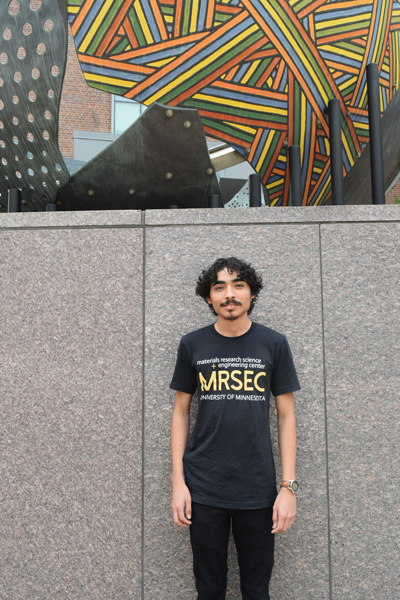
Home Institution: The University of Washington
REU Mentor: Vivian Ferry
Using Shadows Of Tailored Microspheres To Create Optical Metasurfaces
Metasurfaces are engineered nanostructures that manipulate light in specific ways that are useful for a variety of applications. The traditional method of creating metasurfaces is expensive and is only able to create a small area. Shadow sphere lithography (SSL) is a low-cost solution that can be scaled for larger areas. This technique involves arranging spherical particles in a hexagonal pattern on a substrate, utilizing them as shadow masks during oblique angle evaporation of functional materials to form desired metasurface structures. To overcome the constraints of hexagonal arrangements, we replaced the planar substrate for sphere deposition with a topographically patterned substrate. This approach enabled precise filling of wells on the patterned substrate with spheres, while keeping the raised areas free from spheres through "discontinuous dewetting." Tailoring parameters such as sphere ink printing speed and surface tension facilitated this process. After deposition, spheres were transferred to a planar substrate via transfer printing. This process involved placing the sphere-coated patterned substrates on a semi-cured NOA layer, followed by UV treatment. After UV treatment, the patterned substrate was peeled off, leaving the spheres atop the planar NOA. Experimental results demonstrate potential microsphere arrangement control, paving the way for diverse SSL metasurfaces.
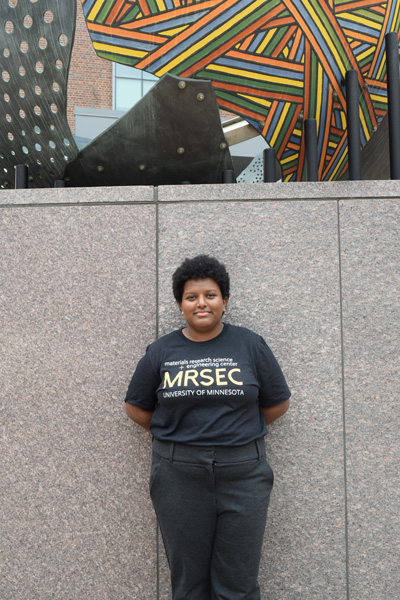
Home Institution: University of Alabama
REU Mentor: Michelle Calabrese
Magnetic field induced ordering of block copolymers
Poloxamers are amphiphilic ABA type triblock co-polymers that act like a surfactant in water, creating a micelle with a “B” type hydrophobic polypropylene oxide core and “A” type hydrophilic polyethylene oxide coronas. They are widely applicable as hydrogels; notably, they have been utilized in biocatalysis, drug delivery, and drug stability. In this project, we probed an atypical response of disordered poloxamer solution to ordered gel transition in response to magnetic fields. The behavior of a poloxamer solution in presence of an applied magnetic field (B= 0.5T) was investigated using magnetorheology, where the rheological characteristics of the samples were studied while exposed to an in situ magnetic field. Specifically, the time required by the poloxamers to transition from their disordered to gel state under magnetization, referred to as critical time, was tracked as a function of block ratio and molecular weight. The gels were characterized using small-angle x-ray scattering (SAXS), which revealed structural information about the gels obtained post-magnetization for 3 hours beyond the critical time. The critical time decreased exponentially and the modulus remained relatively consistent when increasing the molecular weight of the poloxamer. These results are helpful for future applications by demonstrating the tunability of magnetically-induced poloxamer gels.
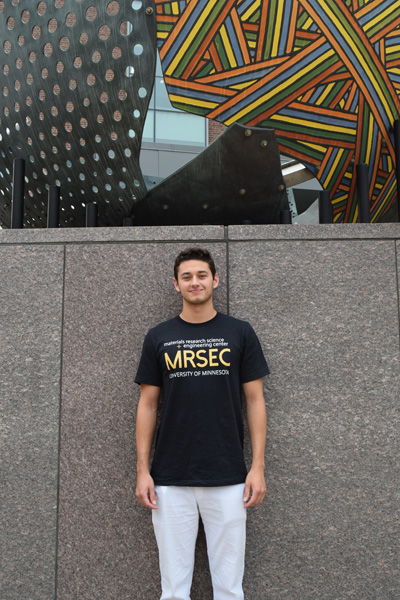
Home Institution: University of Florida
REU Mentor: Russ Holmes
Self-assembling Patterns in Organic Semiconducting Thin Films
Micrometer-scale periodic patterns have been shown to increase outcoupling efficiency for OLED and photonic devices [1]. However, lithography-free methods such as thin film wrinkling require multiple layers and the application of anisotropic stress [2]. Recently, a thermal annealing-driven method demonstrated the propagation of self-assembling patterns, tunable from a range of 800 – 2400 nm, simultaneously with crystallization [3]. The goal of this project is to optimize this phenomenon by using organic molecules with a low bulk glass transition temperature (Tg) to increase suitability for OLED devices. To do this, organic molecules (4,7-Diphenyl-1,10-phenanthroline (Bphen) and N,N′-diphenyl-N,N′-bis(1-naphthyl)-1,1′-biphenyl-4,4 (NPB)) were deposited on a silicon substrate using physical vapor deposition (PVD). Ellipsometry was then used to characterize deposited film thickness, and films were annealed using a heating stage at 20 - 60°C above their respective Tg. Pattern growth was then observed under an optical microscope and analyzed by using timeseries imaging to measure crystalline growth rates. Results reveal the presence of pattern formation in NPB at 140-155°C, while Bphen exhibits the potential for this phenomenon when annealed from 95 - 110°C. Observing pattern formation in a low Tg molecule increases the likelihood of corrugated structure implementation onto OLED devices with this phenomenon.

Home Institution: Colorado School of Mines
REU Mentor: Mahesh Mahanthappa
Self-Assembly Behavior of Asymmetric Homopolymer-Core-Shell Hybrid Block Bottlebrush Copolymers
Network phases formed by the self-assembly of block copolymers have the potential to be utilized in applications ranging from nanotemplating to drug delivery. One way to expand beyond linear block copolymers is through architectural changes such as bottlebrush polymers, because they allow access to morphologies that are otherwise difficult to obtain. The group has previously synthesized novel hybrid bottlebrush polymers with segments of homopolymer and core-shell side chains which were able to phase separate into lamellar and double gyroid (Q230) networks based on the side chain composition along the backbone. To fully understand the formation and packing arrangement of this system, a modified compositionally asymmetric core-shell side chain version was studied. Macromonomer side chains of the asymmetric hybrid bottlebrushes were synthesized utilizing sequential ring-opening transesterification polymerization (ROTEP) with 5-norbornene-2-exo-methanol as the initiator, and ε-decalactone and D,L-lactide as the monomers. The bottlebrushes were polymerized using a grafting-through approach with sequential ring-opening metathesis polymerization (ROMP) on the two side chains. All polymers were characterized using 1H-NMR and size exclusion chromatography (SEC), and microphase separation was determined with small-angle X-ray scattering (SAXS). Future work will consist of exploring the network phase formation of other asymmetric side chain compositions and double-grafted hybrid bottlebrush polymers.

Home Institution: North Carolina State University
REU Mentor: Ben Hackel
Investigating Protein-Only Ligands' Inhibitory Potential in Protein-Small Molecule Hybrids for Drug Discovery
Molecular targeting is a powerful technique utilized in therapeutics, diagnostics, and fundamental biology research, involving binding ligands such as proteins and small molecules. Despite their individual advantages, both classes exhibit limitations. Protein—small molecule hybrids (PriSMs) have the potential to merge the beneficial aspects of each class. During our investigation into new PriSMs targeting carbonic anhydrases (CAs), we discovered unconjugated proteins capable of binding to the targets in the absence of small molecules. In this study, we focus on the identification and characterization of these protein-only binders, specifically exploring the inhibitory potential of fibronectin, a protein-only ligand, against carbonic anhydrase isoforms II, IX, and XII. Employing fluorescence-activated cell sorting (FACS), we isolated fibronectin clones initially identified as PriSMs that exhibited binding to these isoforms in the absence of small drug molecules. Sanger DNA sequencing allowed us to identify candidate clones for activity determination, followed by extraction and transformation into E. coli to enable large-scale protein production. The produced proteins will be purified using metal-affinity chromatography, and their inhibitory efficacy evaluated through a 4-nitrophenyl acetate carbonic anhydrase activity assay. This study’s findings will shed light on the unique behavior of these protein-only binders, enhancing their potential applications in drug discovery.
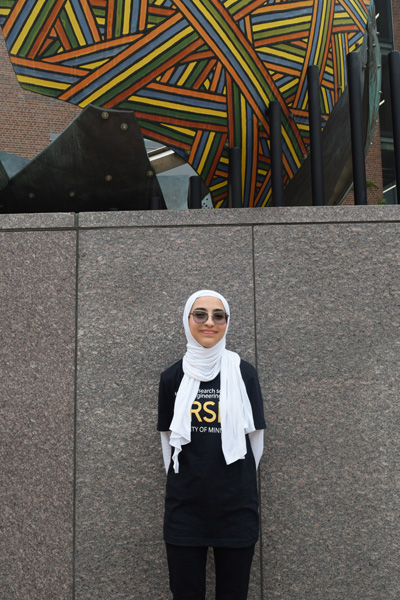
Home Institution: The University of Texas Rio Grande Valley
REU Mentor: Chris Ellison
Improving Thermal Stability of PS and PS-b-PLA Double Gyroids with UV Crosslinking
Gyroids are complex 3D structures used in applications such as biosensing and optics. Useful inorganic gyroids can be templated from the self-assembly of block copolymers; however, often this requires elevated temperatures. The goal of this project was to improve the thermal stability of polystyrene-block-polylactic acid (PS-b-PLA) double gyroid templates by optimizing UV crosslinking conditions (wavelength, intensity, and time). Initially, chemical stability was used as a proxy for thermal stability and tested by soaking crosslinked PS thin films in toluene and then measuring the remaining thickness via spectroscopic ellipsometry. Morphological changes in the films were observed using the optical microscope and SEM. The optimal UV exposure was determined to be 3 hours at a wavelength of 183 nm with an intensity of 5 mW/cm2. Contact angle testing revealed oxidation of the films, possibly due to the UV source creating ozone. This condition was then used to crosslink self-assembled PS-b-PLA films and PS templates prior to thermal stability testing.
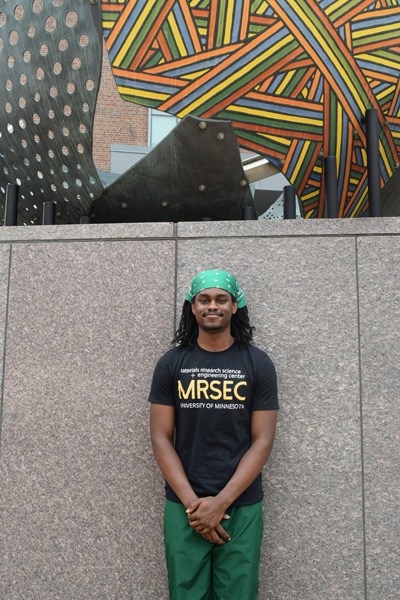
Home Institution: Augsburg University
REU Mentor: Xiang Cheng. Moumita Dasgupta
Visualizing Hydrodynamic interaction of scaled up Flagella Model
The physical swimming mechanisms used by microorganisms like bacteria are different compared to larger animals like humans. Escherichia Coli (E. Coli) bacteria use hair-like structures called flagella for locomotion. During translational movement, the flagella intertwine to create a bundle, the physical basis of which is not fully understood. To understand flagellar bundling, we created a macro model of four active flagella and one passive flagellum in silicon oil. We are testing if the four active flagella rotating together can give rise to sufficient drag in the surrounding fluid which is capable of propelling the passive one. The Reynolds number (the inertial force divided by the viscous force) is kept constant with actual bacteria (~10^-2). We use Particle image velocimetry (PIV), using tracer particles and laser sheet. I will discuss the experimental design and computational implementation of PIV and then show results obtained in terms of the mean flow field and vorticity for a single model flagellum and how we can extrapolate that learning to our actual five flagella setup.
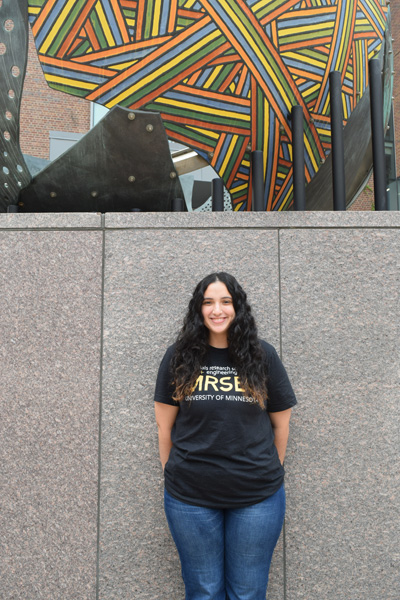
Home Institution: University of Puerto Rico
REU Mentor: Boya Xiong
The stability of Moringa Oleifera protein enabled antiviral face covering for airborne coronavirus controls
There’s an urgent need for solutions to combat viral infections. This issue is crucial for establishing personal protective equipment (PPE), since current antiviral agents exhibit limitations such as reduced efficacy, potential toxicity, and antibiotic resistance. The protein from the Moringa oleifera (MO) tree, which belongs to host defense peptides that has superior antimicrobial and antiviral properties, but with little cytotoxicity, and do not induce resistance. The stability of the coated material is equally vital due to stable coating ensures the longevity of the material's antiviral properties. We developed an antiviral textile coated with MO protein through simple electrostatic binding, inactivating the virus and preventing its transmission. Under various conditions, we’ll determine their suitability for use as PPE. Specifically, the efficacy of materials aged at room temperature for 10, 30, and 60 days, their response to repeated exposure (5 cycles) to a mimetic coronavirus, and impact of thermal changes from 25 ˚C to 50 ˚C. Finally, we will conduct laundry cycles (2, 4, 6, 8) coating testing to evaluate the ability of the coating to detach and be recoated. The research aims at the stability of the coated materials allowing the development of successful and extended antibacterial textiles applied as PPE.
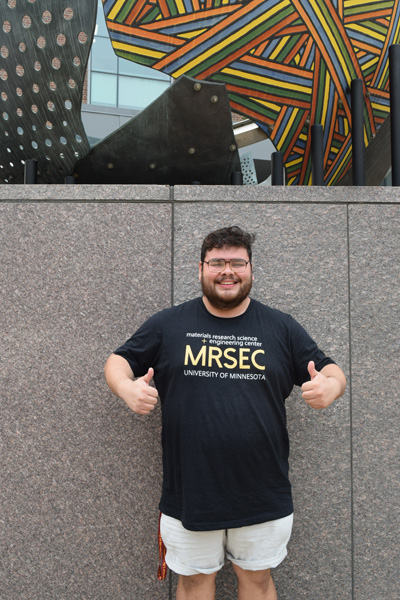
Home Institution: University of Texas Rio Grande Valley
REU Mentor: Michelle Calabrese
RAFT photopolymerization of PNIPAM based block copolymers
Poly(N-isopropyl acrylamide) (PNIPAM) has been studied for various biomedical applications such as drug delivery, wound dressings, and, specifically, sensing via hydrogels due to a characteristic phase transition around 32C. An avenue to improve the sensitivity of PNIPAM hydrogel biosensors is by increasing the surface area via gelling PNIPAM nanofibers. This summer, block copolymers (BCPs) containing PNIPAM were synthesized using photo reversible addition-fragmentation chain transfer (RAFT). While RAFT is a commonly used controlled polymerization technique, photoinitiated RAFT can yield polymers with ultra-high molecular weights and can be performed under mild conditions. Therefore, photoinitiated RAFT is promising for synthesizing polymers ideal for nanofibers and hydrogels due to enhanced viscoelastic and mechanical properties. A compact UV setup was implemented using a commercially available nail curing device and varying the light intensity. The methodology was optimized using common lab equipment to enable widespread implementation. Alongside PNIPAM, the highly hydrophilic poly(N,N-dimethyl acrylamide) (PDMA) is a promising candidate as a stabilizing block since it improves the mechanical properties of hydrogels. Hence, BCPs using PNIPAM, PDMA may produce mechanically strong, thermoresponsive, fibers with distinct morphologies that can be subsequently processed into hydrogels ideal for robust sensing applications.

Home Institution: Arizona State University
REU Mentor: Jessica Lamb
Synthesis of a Stable Photocatalyst for Cationic-Anionic Switchable Polymerization System
Block copolymers have potential applications in areas such as membranes and drug delivery because they can self-assemble into nanostructures, but a current barrier to implementing them is the complex synthesis process, particularly when each block uses a different polymerization mechanism. In this case, synthesis traditionally requires end-group modification of each individual block. One proposed solution is a “one-pot” switchable system with a universal mediator and using external stimuli to control the polymerization sequence: a photocatalyst could perform cationic polymerization when the solution is exposed to light, then anionic polymerization occurs when the solution is heated without needing a separate end-group modification step. This requires a photocatalyst with redox potentials that can perform cationic polymerization and that is neutral so it remains stable in contact with the anionic components of the system. The project involves the synthesis of a neutral photocatalyst (3,6-CF¬3-4CzIPN) hypothesized to possess these target redox potentials. Each step in the synthesis will be analyzed using NMR spectroscopy and variables (time, heat) will be altered to optimize the yield. Upon successful synthesis of 3,6-CF¬3-4CzIPN, its redox potentials will be measured using cyclic voltammetry and fluorescence spectra and its photocatalytic abilities tested in the cationic polymerization of vinyl ethers.
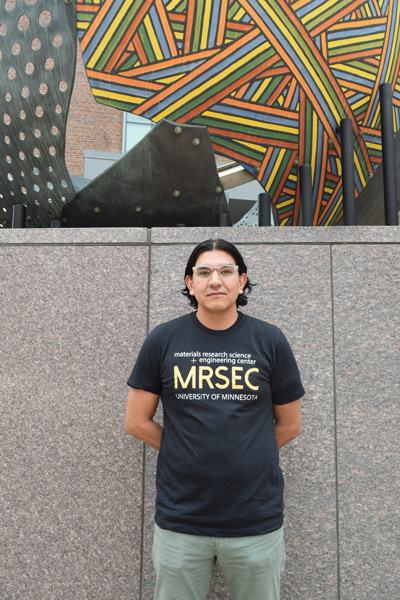
Home Institution: University of Minnesota
REU Mentor: Tim Lodge
Phase behavior of architecturally complex bottlebrush block co-polymers
Block co-polymers self-assemble into various morphologies some of which include 3D networks (NETs). NETs are triply periodic structures that percolate in three dimensions made up of two chemically distinct domain. This allows us to tune the properties of the material and
incorporating two or more functions such as mechanical and transport properties. These periodic interpenetrating domains give rise to orthogonal properties like ion conduction and mechanical strength. Unfortunately, NETs formation only takes place over a small compositional window. Additionally, accessing domain sized greater than 50 nm becomes difficult as self-assembly kinetics decrease exponentially with increasing molecular weight. Here, we plan to use architecturally asymmetric block copolymers where one block is linear and the other is a
shaped bottlebrush. More specifically we will be focusing on a cone shape, where the bottlebrush block decreases in size from the linear block. Small angle- X-ray scattering will be used to characterize the morphology of the polymers. We will use size exclusion chromatography and 1 H NMR to characterize the polymers. We are looking to explore a variety of ordered morphologies by changing the shape of the brush and studying how the different shapes affect self-assembly behavior.
School: White Bear Lake High School
Mentor: Jane Wissinger
Title: Synthesis and Applications of Iron Magnetic Nanoparticles in the High School Chemistry Classroom
Iron magnetic nanoparticles (Fe MNPs) were synthesized utilizing a novel procedure that can be performed in a high school chemistry lab. Iron (II) sulfate heptahydrate served as the source of Fe, and plant-derived starches were used as both a stabilizing and reducing agent. Three different starches, potato, corn, and tapioca, were utilized. The physical properties of the Fe MNPs, including color and magnetic strength, were then analyzed. The type of starch used did not affect the color or magnetic strength. However, the time the wet Fe MNPs were exposed to air did affect the color and magnetic strength of the nanoparticles. Finally, in order to explore real-world applications of Fe MNPs, the Fe MNPs were used to degrade rhodamine b and methylene blue dyes. Connections to the high school chemistry curriculum, considerations for the high school lab, and potential extensions were explored throughout the experiment.
School: Waconia High School
Mentor: Vivian Ferry
Title: Optical Properties of Mechanically Altered LSCs
Luminescent Solar Concentrators (LSCs) are a large area light harvesting device. These LSCs send this concentrated light into a thin strip of photovoltaic cells to generate electricity. The surface of LSCs can be damaged when placed outside in the elements over a period of time. We explored how mechanical alteration affected the transmission and attenuation of the LSCs under various wavelengths of light. We utilized transparent acrylic slides that are integrated with inorganic florescent dyes for our LSCs. We then applied various amounts of mechanical alteration to the backside of the acrylic LSC using sandpaper. We found that mechanically altering the back surface does not significantly reduce the concentrated photoluminescence while it drastically reduces the intensity of transmitted light. High School students will be asked to create an experiment that is based upon our research. They will be altering the surface of their LSCs so that they may measure the optical properties under various light sources using the light sensor on their smartphones. This is an engaging project that fits well within new Minnesota education science standards that introduces students to the concepts of light, optics, and green energy through the use of LSCs.
School: Thomas Edison High School
Mentor: Mark Distafano
Title: An Example of Phenomenon-Based Learning Through the Exploration of Protein Prenylation in Algae
The 2019 Minnesota State Science Standards are shifting focus from content-driven learning to the use of scientific practices to explore and understand new phenomena. This project will use protein prenylation in algae as an anchoring phenomenon in both biology and chemistry
courses to support a collaborative multi-year project. Students in chemistry will learn the synthesis of a fluorescent prenylation probe through a click reaction. Students in biology will use a synthesized probe to prenylate proteins in algal cells and visualize the resulting
product using gel electrophoresis and staining.
School: Thomas Edison High School
Mentor: Mark Distafano
Title: An Example of Phenomenon-Based Learning Through the Exploration of Protein Prenylation in Algae
The 2019 Minnesota State Science Standards are shifting focus from content-driven learning to the use of scientific practices to explore and understand new phenomena. This project will use protein prenylation in algae as an anchoring phenomenon in both biology and chemistry courses to support a collaborative multi-year project. Students in chemistry will learn the synthesis of a fluorescent prenylation probe through a click reaction. Students in biology will use a synthesized probe to prenylate proteins in algal cells and visualize the resulting product using gel electrophoresis and staining.
School: Thomas Edison High School
Mentor: Mark Distafano
Title: An Example of Phenomenon-Based Learning Through the Exploration of Protein Prenylation in Algae
The 2019 Minnesota State Science Standards are shifting focus from content-driven learning to the use of scientific practices to explore and understand new phenomena. This project will use protein prenylation in algae as an anchoring phenomenon in both biology and chemistry
courses to support a collaborative multi-year project. Students in chemistry will learn the synthesis of a fluorescent prenylation probe through a click reaction. Students in biology will use a synthesized probe to prenylate proteins in algal cells and visualize the resulting
product using gel electrophoresis and staining.
UMN MRSEC
435 Amundson Hall, 421 Washington Ave. SE, Minneapolis, MN, 55455
P: 612-626-0713 | F: 612-626-7805